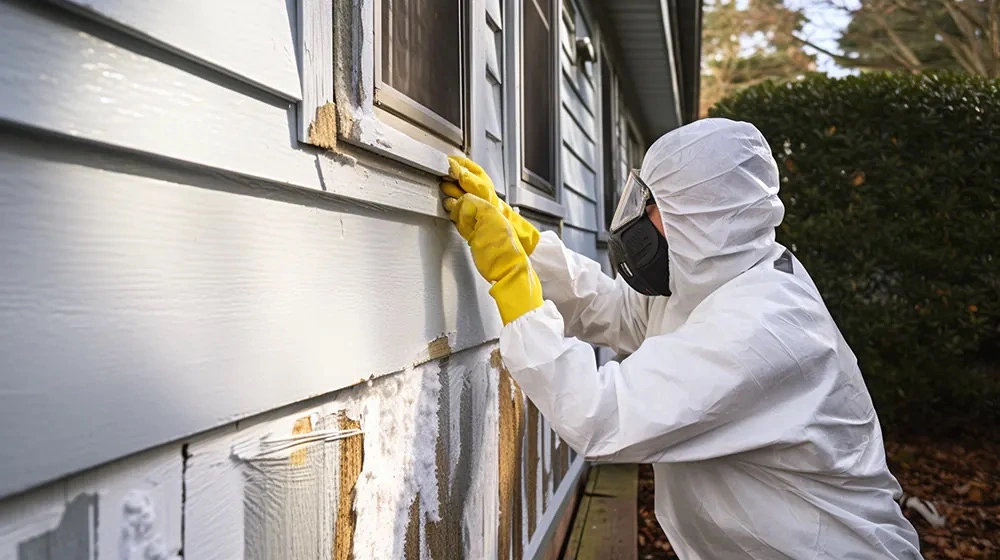Phone:
720-399-3335
Office address:
1685 S. Colorado Blvd. Suite 151, Denver, CO 80222
You can recognize asbestos siding by its fibrous texture, cement-like appearance, and typical colors ranging from gray to bluish-gray. Look for hues like white, yellow, green, brown, gold, or even black depending on the type. It often appears as cement shingles with a somewhat brittle nature, especially in homes built between the 1940s and 1970s. If disturbed, it can release harmful fibers into the air. Asbestos siding remains a concern in 2024, and identifying specific patterns and colors can help you spot it, but professional inspection is vital. The next steps will provide further essential insights into handling and addressing asbestos siding safely.
You’ll find that asbestos siding comes in various types, each with unique characteristics.
Common forms include actinolite, which ranges from white to green, and amosite, known for its brown or black hue and coarse texture.
Other types like chrysotile, crocidolite, and tremolite also have distinct colors and textures, making it essential to recognize these differences for proper identification and safety.
To identify asbestos siding, start by examining your home’s age and the siding’s appearance. Homes built between the 1940s and 1970s are more likely to contain asbestos siding, which often has a fibrous texture and a grayish or bluish-gray color.
For a definitive answer, it’s best to get a professional inspection to safely confirm the presence of asbestos.

Identifying asbestos siding involves looking for specific visual characteristics such as a fibrous appearance, gray or bluish-gray color, and a textured surface that can resemble cement shingles. You’ll want to check for these features to determine if your siding contains asbestos:
In 2024, it’s crucial to consider your home’s construction date, especially if it was built between the 1940s and 1970s, to assess the potential presence of asbestos siding. During this period, asbestos was commonly used in building materials due to its durability and fire-resistant properties.
If your home falls within this age range, there’s a higher likelihood it contains asbestos siding. Take a close look at the siding itself; older asbestos siding often has a distinct wavy pattern on the bottom edge and is usually gray or bluish-gray. These sidings are also brittle and prone to cracking.
If you’re unsure about the age or materials of your siding, reviewing property records or consulting an expert can provide further insights.
Engage a professional inspection service like Enviocore to accurately determine if your home’s siding contains asbestos, ensuring safety and compliance with health regulations.
Identifying asbestos siding is essential because disturbing it can release harmful fibers into the air, posing serious health risks. Professionals use specialized methods to assess the presence of asbestos without causing damage.
Call Now
You Can Call Us At This Number: 720-399-3335
The dangers of asbestos siding primarily arise when its fibers are disturbed and become airborne, posing serious health risks. Inhalation of these fibers can lead to severe illnesses like asbestosis, lung cancer, and mesothelioma.
When asbestos siding is damaged, whether through wear and tear, renovations, or natural disasters, it releases microscopic fibers into the air. You might not notice these fibers, but they can easily be inhaled and become lodged in your lungs. Over time, this exposure can lead to chronic respiratory issues and cancer.
In 2024, with heightened awareness of health risks, it’s more important than ever to avoid disturbing asbestos siding and to seek professional help if you suspect it’s present in your home. Proper handling ensures your health and safety, minimizing the risks.
Considering whether to remove asbestos siding depends largely on its current condition and potential health risks. If the siding is intact and undisturbed, it may pose little danger. However, damaged or deteriorating siding can release harmful asbestos fibers into the air.
Here are key points to ponder:
Ultimately, evaluating the condition and seeking professional advice will help you make an informed decision about asbestos siding removal.
Asbestos siding typically lasts around 50 to 80 years. You’ll find it durable and resistant to weather, but its condition can worsen over time. Regular inspections are vital to guarantee it remains safe and intact.
Did you know 30% of older homes might have asbestos siding? Yes, you can paint asbestos siding. Just make sure it’s undamaged, clean it thoroughly, and use a quality exterior paint to seal and protect it.
Yes, you can cover asbestos siding with new siding. Make sure you hire professionals who’ll properly install the new layer without disturbing the asbestos, thereby preventing harmful fibers from being released and ensuring safety.
Yes, you can find grants or financial aid for asbestos siding removal. Check local government programs, non-profits, and health departments. They often offer assistance to help reduce the financial burden of safe asbestos removal.
In your quest to maintain a safe home, recognizing asbestos siding is essential. It’s often found in older homes, looking like brittle, fibrous cement shingles in gray or bluish-gray hues.
Spotting these can be like finding a needle in a haystack, but it’s vital for your health. If you suspect asbestos, don’t DIY—call a professional for removal.
As we move through 2024, your diligence in identifying and addressing asbestos siding will guarantee your home remains a sanctuary, free from hidden dangers.